Clivia: varieties and home care

Clivia stands out among ornamental plants for its absolute unpretentiousness and ability to bloom at the end of winter, delighting the owners with bright exotic flowers. In order for the plant to develop without problems throughout the year, it is important to provide it with proper care, depending on the season.
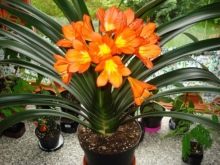
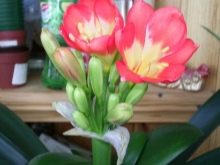
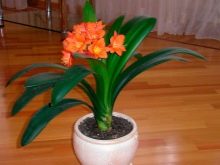
Peculiarities
Clivia is an evergreen perennial with branched roots reaching out to the surface. This houseplant belongs to the amaryllis family, but unlike its other representatives, it does not have a bulb. A brief description of the plant's appearance suggests that the leaves are large, fleshy and adjacent to each other. Clivia does not have a full-fledged stem; a shoot similar to it is formed from a bunch of leaves. The height of the bush varies from 40 to 60 centimeters.
The leaf blades themselves are covered with a glossy dark green skin and have elasticity, and therefore bend easily. The length of one varies from 40 to 75 centimeters, and the width does not go beyond 5-8 centimeters. Sometimes there is a depression in the place of the central vein. Each year, the number of leaflets in the outlet increases by 5-6 pieces. Bloom is usually expected from February to March.
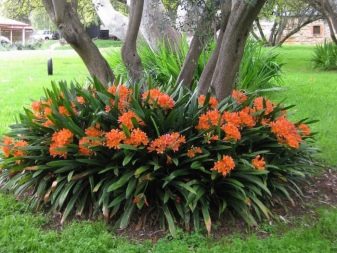
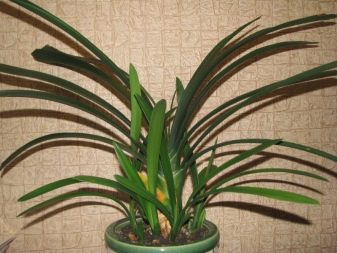
First, a peduncle is formed in the center of the rosette, the length of which ranges from 20 to 40 centimeters. After that, up to 30 buds open on its top, forming an inflorescence with a diameter of 15 to 20 centimeters. Each individual flower resembles a bell and has 6 petals. The red, orange or pink color of the clivia looks very beautiful. There are long stamens and an ovary inside the flower.
AThe plant's rum is very unusual - it combines vanilla, nutmeg, herbal and pink scents. Fruiting occurs with the formation of a fleshy berry.
It is important to mention that clivia is a poisonous culture: neither its roots nor leaves can be eaten. At the very least, they will provoke diarrhea, vomiting, or collapse.
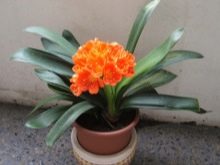
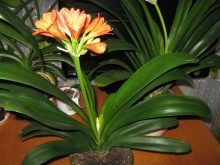
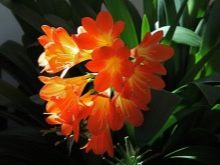
Varieties
The clivia species are not very diverse. Clivia gardena has elongated leaves that grow up to 50 centimeters. They have a glossy, dark green skin with parallel stripes. The edge of the plate is pointed. A cylindrical peduncle with a height of 45 to 50 centimeters is covered with small red bells, which gather in inflorescences, consisting of 15 buds. This variety blooms in the second half of winter.
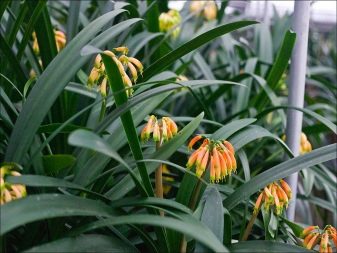
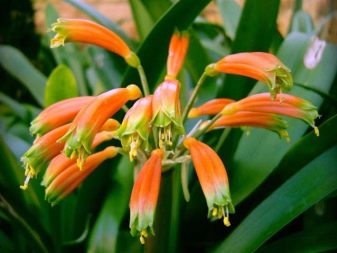
Clivia cinnabar, she is miniat or orange, has dense leaves, the length of which reaches 70 centimeters. The plates are colored dark green and resemble straps. The buds themselves are colored red and orange, and the core is yellow. The lush inflorescence contains up to 20 flowers. The height of the peduncle is in the range from 40 to 50 centimeters.
This species is the most popular among breeders and is the basis for various decorative varieties. This variety blooms from February to May, but sometimes at other times of the year.
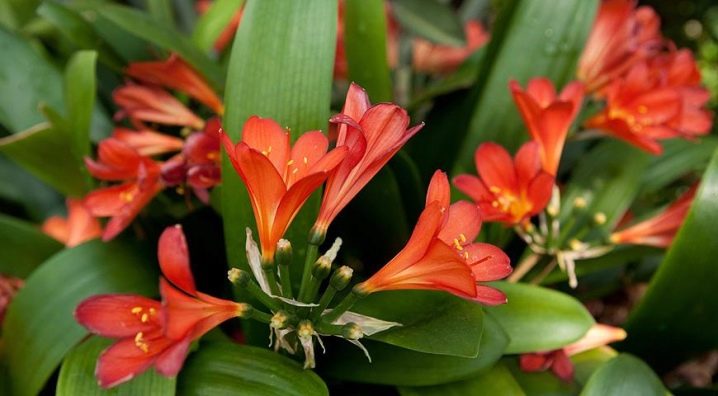
Clivia, beautiful or noble, grows only up to 30-50 centimeters, therefore, it is considered miniature... A dense rosette is formed from xiphoid pointed leaves. The peduncle itself is dense and thick, its length is from 30 to 50 centimeters. From 40 to 60 bell-shaped buds are formed on it.As a rule, they are colored pinkish and have two centimeter petals. This variety blooms in the second half of winter.
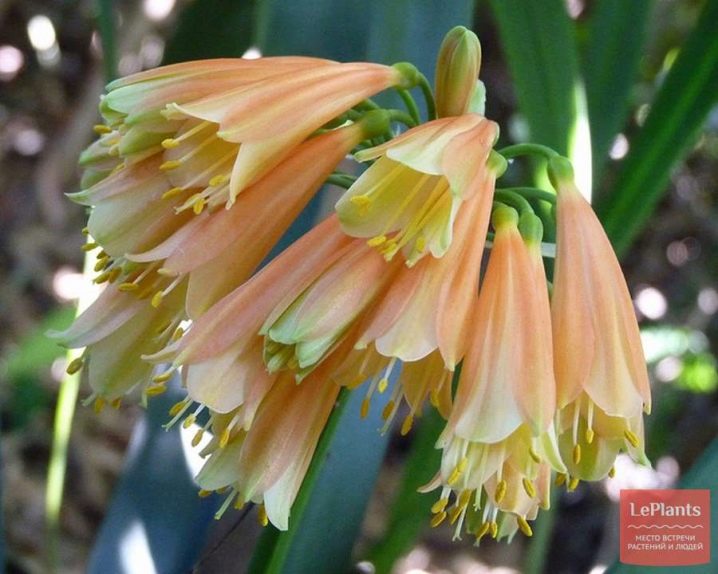
If we talk about the results of selection, then these include, for example, clivia is white. It grows up to 70 centimeters. On the peduncle, about 20 snow-white flowers are formed, resembling a bell. The leaves are long and fleshy, of a standard appearance.
Clivia variegated reaches 50 centimeters. Dark green glossy plates have a white stripe in the middle. The peduncle is covered with red-orange bells. Flowering occurs at the junction of spring and summer.

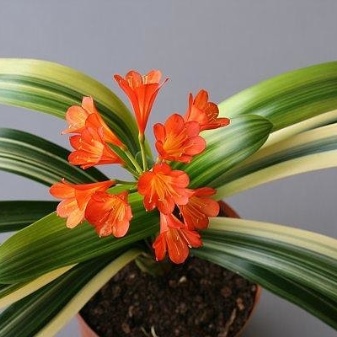
Home care
In order for the clivia to please the owners with its appearance, it is necessary not only to choose the right place of its habitat, but also to carry out all the care measures according to the instructions.
Lighting
Lighting should be moderately bright, but diffused. Direct streams of light will cause burns and other damage to the sheet plate. The pot with the plant can be placed on the windowsills facing east or west, or removed deep into the room, the windows of which face south.
If the light of the clivia is not enough, then it will stop flowering.
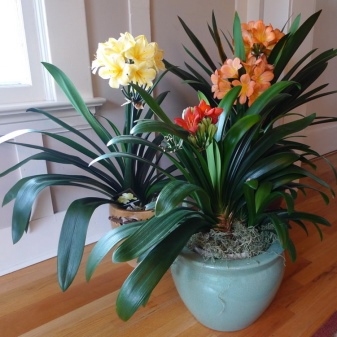
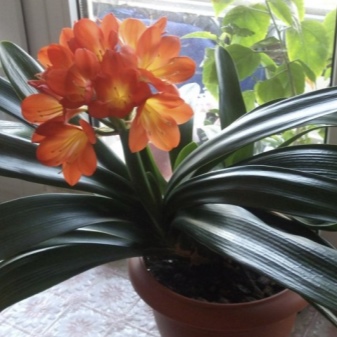
Temperature
Clivia feels most comfortable at a temperature that does not go beyond 20-25 degrees. In the summer, it is recommended to provide ventilation of the room, but avoid drafts. You can even move the landings to a balcony, loggia or a personal plot, providing protection from the bright sun and gusts of wind.
During the rest period, the flower is transferred to a cool room, and then, after the appearance of a flower arrow, is returned to a warmer one.
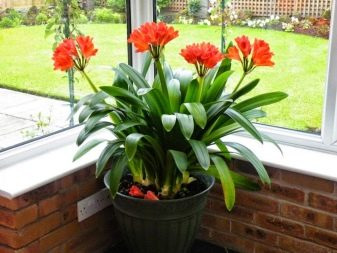
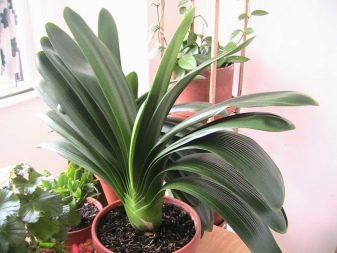
Watering and fertilizing
Clivia reacts negatively to waterlogged soil. Watering should be carried out when the top layer dries up by a couple of centimeters. If after the procedure a lot of liquid flows into the pan from the drainage holes, then it should be drained immediately. Otherwise, root decay is likely. Plain tap water should not be taken, therefore, before irrigation, it will have to be allowed to stand to get rid of chlorine ions.
This plant does not need high humidity, so there is no need to install a humidifier or regular spraying. However, in the summertime, the bush should be bathed in warm shower water, and in other seasons - wipe the surface of the sheets with a damp cloth.
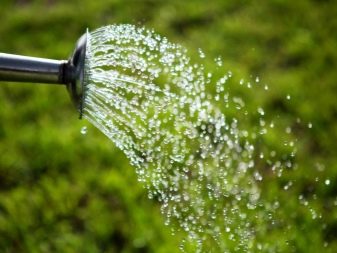
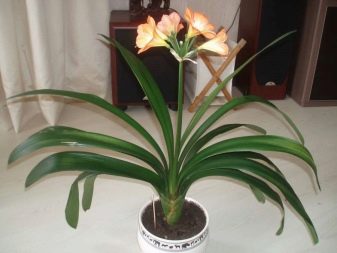
When deciding how to feed the clivia, preference should be given specialized formulations or complexes suitable for flowering plants. The only requirement is the absence of a large amount of nitrogen that can inhibit flowering, since all forces will be used to build up green mass.
Experts recommend alternating between liquid organic matter and a ready-made mineral complex. Fertilizers are usually applied from the beginning of the growing season until September. The procedure is usually performed every two weeks.
Suitable organic matter should contain vermicompost in the composition. For example, it can be means "Ideal" or "Breadwinner"... Usually a tablespoon of fertilizer is dissolved in a couple of liters of water. From mineral fertilizers, gardeners prefer Ammophos or Kemir. In this case, a couple of grams of top dressing is diluted in a liter of water. Phosphorus must be present in the composition of these funds.
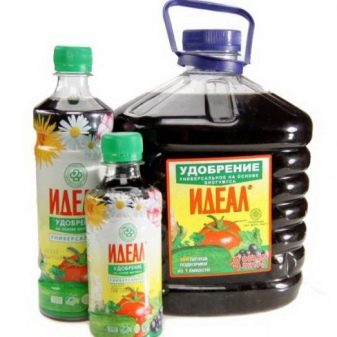
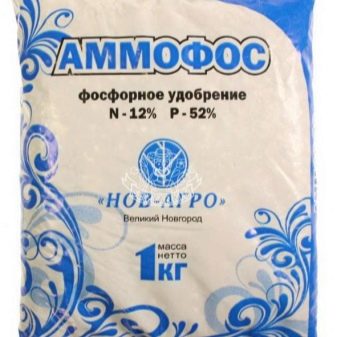
Priming
Loose and slightly acidic soil is suitable for a plant. The easiest way to get it is to mix sand, leafy earth and sod, taken in equal proportions. We must not forget about the importance of disinfecting the substrate to prevent the development of diseases and the reproduction of insects. Experts do not recommend using chemical agents for soil cultivation, since they destroy all microorganisms contained in it, including useful ones. If the soil is being prepared for young plants, it can be made looser by adding perlite or sand.
When placing soil in a pot, one should not forget about the importance of preliminary formation of the drainage layer.
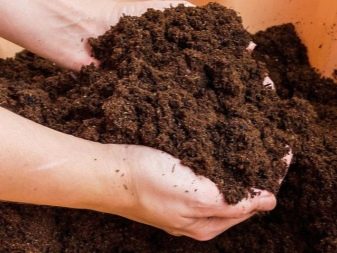
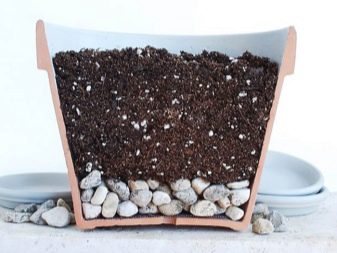
Bloom
Clivia, obtained from seeds, begins to bloom only in the fourth year of life. If a different method was used for reproduction, then flowers can be expected already in the second year of existence. A delay in flowering can be due to a lack of adequate rest periods. If the conditions were met, then in the winter in the second half, an arrow of the peduncle will appear. As soon as its length reaches 10 centimeters, it is time to take the planting out of a state of rest.
In order for the clivia to bloom further, it immediately needs to arrange a warm shower, increase the frequency and amount of watering, and also return top dressing in the form of mineral fertilizers containing potassium.
Alternatively, it can be sodium sulfate, potassium salt, or potassium chloride.
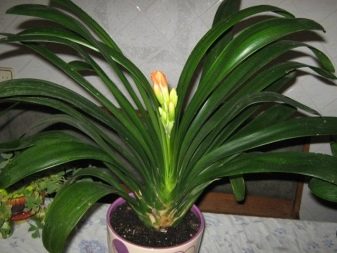
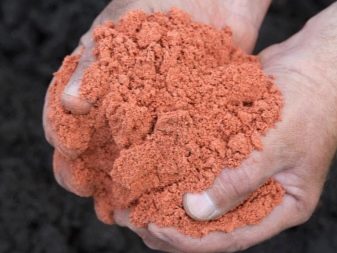
The pot is transferred to the sill of a window facing west or east, but protected from direct sunlight. It is important that the temperature does not go beyond 20-25 degrees. Watering is carried out regularly, but not abundantly, so that the soil remains slightly moist. Top dressing is carried out every two weeks. From time to time it is worth wiping the dust off the sheets. Typically, the bush blooms for 20 to 25 days. At this time, the capacity it is not recommended to move, transfer somewhere or even rotate around its axis.
In principle, clivia can even be made to bloom if it cannot do it on its own. To do this, the temperature in the room is reduced to 15-16 degrees, and the lighting is made weak for a period from a couple of weeks to a whole month. The need for this appears when the plant has been improperly cared for during the dormant period, or it has grown too large and requires diving in several pots. The reason may be an overly spacious and wide container. Clivia will bloom only when the roots completely fill the volume.
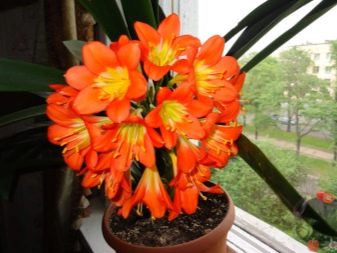
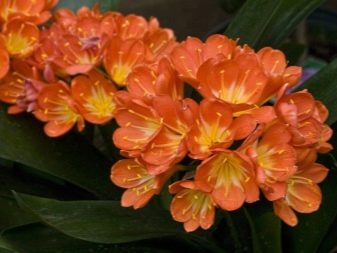
Dormant period
Somewhere from October or November until midwinter, the clivia is dormant. The pot with the plant must be moved to the windowsill of windows facing north, and the care system must be temporarily changed. Lighting is limited, and the temperature is maintained within the range from 12 to 15 degrees Celsius. It is worth watering the clivia twice a month, and completely canceling top dressing. In young specimens, the dormant period should last for a couple of months, but the larger the plant becomes, the longer it will have to rest - from September to February.
Some experts recommend from September, stop watering altogether, but at the same time make sure that leaves do not fall off the bush. If this trouble occurs, then the surface of the soil will have to be slightly irrigated.
If you properly care for the clivia, then at the end of February a flower bud should hatch.
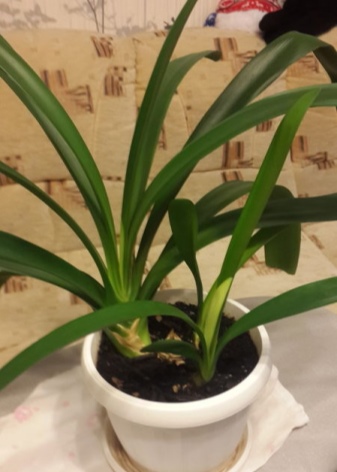

Reproduction and transplantation
For reproduction of clivia, either seeds or lateral shoots, called babies, are used. The second method is considered both simpler and more effective. The babies are carefully separated from the adult plant using a processed tool. If the roots are tangled, then it will be possible to separate them with a knife. The wounds are treated with crushed coal, after which the children are dried for about half an hour. The process is to be planted in a small pot, which is then exposed on a warm and light windowsill. Its flowering will begin in a couple of years.
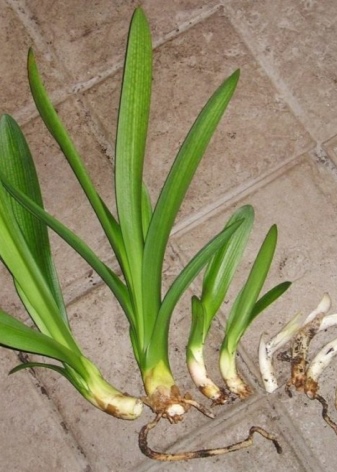

Seed material for clivia is most often purchased in the store, since it is rather difficult to obtain it yourself.... However, some gardeners still try to cope with this task, despite the fact that the full formation of the fruit sometimes depletes the strength of the plant. First, the bush is artificially pollinated using a soft brush. After about 9 months, the fruit should appear. As soon as their color turns red and the structure softens, the seeds can be removed and put into water for a day to swell.
The planting itself is carried out immediately so that the material does not lose its germination. The substrate is formed from peat and perlite or a mixture of peat, turf and sand.The seeds are distributed so that between 2 and 6 centimeters remains between them. The container is covered with a glass sheet or polyethylene. Every day, the greenhouse will have to be opened for a quarter of an hour for ventilation, and the surface of the earth will be moistened.
As soon as the sprout has a full-fledged leaf, it can be dived into a small container filled with humus, clay soil and deciduous soil.
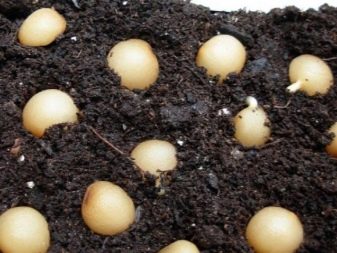

During the transplant, the clivia is under a lot of stress, therefore you should not carry out the procedure until the roots begin to protrude from the pot. An adult plant is not touched at all for a couple of years, after which it is moved to a larger pot as soon as flowering is complete. Only young bushes should be replanted each year. This is done with great care, since the slightest damage to the root system leads to the development of a putrefactive process. When a wound does arise, it is immediately important to treat it with crushed coal.
Clivia, which has already reached the age of 10, does not need to be transplanted... It is enough to simply renew the topsoil with a height of 3 to 5 centimeters. The pot for transplanting does not need to be taken too large, since all efforts will go to the development of the root system, and not to the release of the peduncle.
The width of the new container should only exceed the previous one by 3 centimeters. The importance of the drainage holes should not be forgotten either.
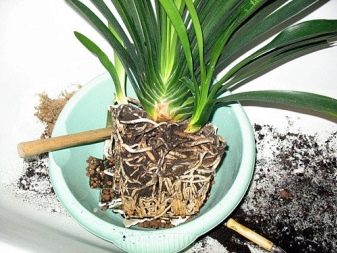
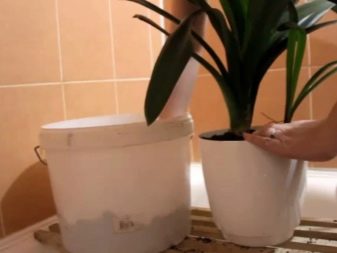
The bottom must be covered with a drainage layer of pebbles, pebbles, broken brick or gravel. Loose soil with low acidity 3 centimeters thick is laid on top. Although this compound can be purchased at the store, it is best to mold your own turf, sand, and leafy soil. For this, 5 parts of leafy earth and sod are taken, as well as one part of sand or perlite. Of the commercial mixtures, the one that is designed for orchids is most suitable. It is important to disinfect the substrate before direct planting.
For example, the soil can be calcined for about 10 minutes in an oven heated to 200 degrees, kept for a couple of minutes in a microwave oven at maximum power, soaked in boiling water or treated with a weak solution of potassium permanganate. This action will get rid of bacteria and pest larvae. About 30 grams of fertilizers containing the required amount of phosphorus, for example, phosphate rock or superphosphate, are added to the treated soil mixture.
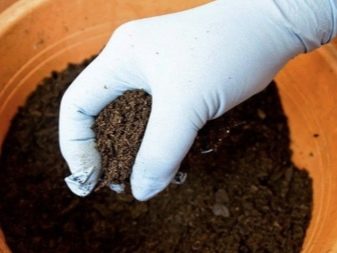
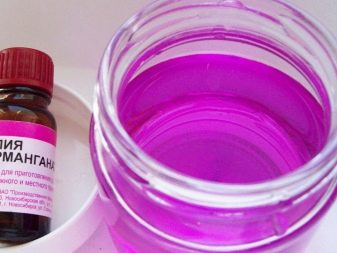
Before transplanting, the plant is moistened and left for a couple of hours, so that later the earthen lump is easier to remove. The roots are carefully washed under the tap and, if necessary, are treated from rot. Having placed the clivia in the center of the container, the voids must be filled with earth.
The root collar should not be buried too deeply, as this will lead to rotting of the lower leaves.
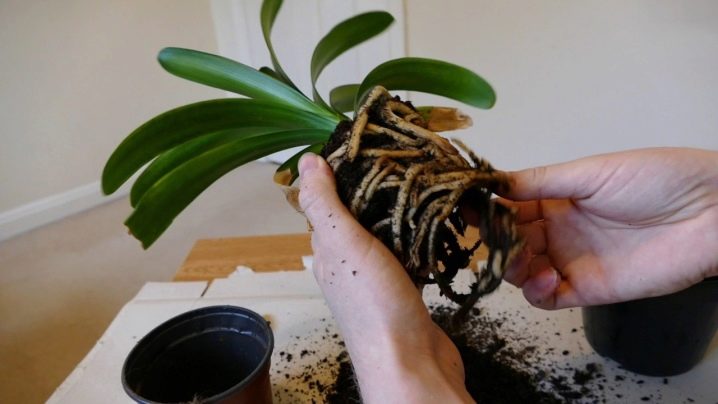
Diseases and pests
Plant breeders' reviews suggest that Pests do not attack clivia often, but if this happens, then their spread occurs very quickly. If you do not take prompt measures, then the plant will even have to be thrown away. Most often it is affected by the scale insect and mealybug - they settle on leaves and buds, feed on juices and thereby inhibit the development of the plant. Rot is considered the most common disease. When dark spots appear on the leaves, resembling growths, we are talking about the scabbard.
To cope with it, first the leaves will have to be treated with a soapy solution, to which a drop of kerosene or denatured alcohol is added for greater efficiency. The shield itself will have to be removed by hand with a damp cotton pad. After completing the processing, the clivia will need to be processed by the "Confidor". "Cotton" lumps on the leaves are the result of the defeat of the mealybug. It can also be removed with a wet cotton pad.
If necessary, the bush is treated with insecticides - "Calypso", "Fitoverm". Such processing must be carried out weekly until the complete destruction of the pest.
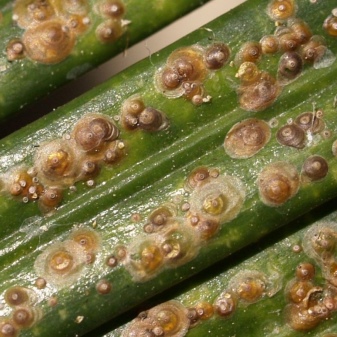
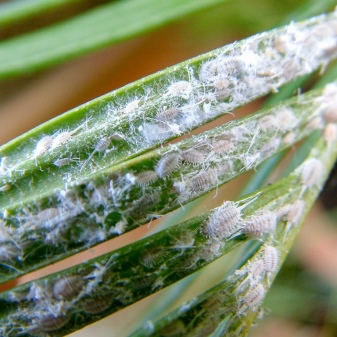
If it became noticeable that the leaves turn yellow, dry and even die off, then the clivia roots have rotted. In this case, it is not necessary to treat the plant, but it will have to be transplanted. The bush is dug up, examined, freed from the affected shoots, sprinkled with charcoal and moved to a new container.
If the lower leaves began to rot, then the transplant went wrong and the root collar went deep into the soil.
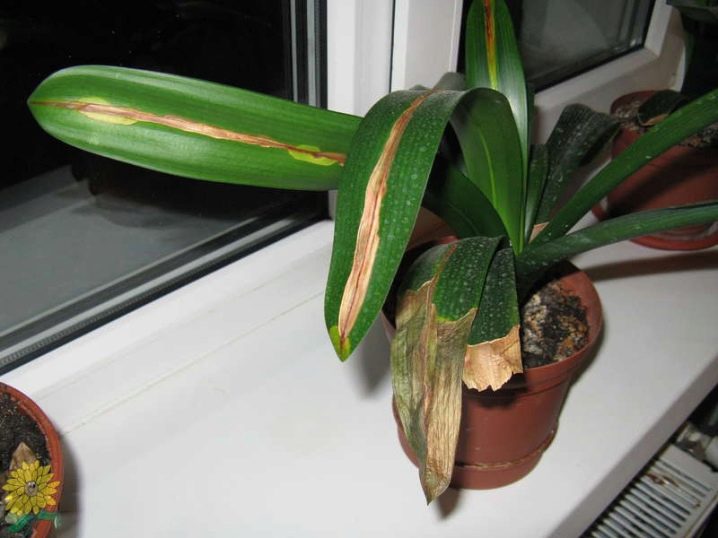
Common mistakes
Caring for the clivia is not difficult, however, some mistakes lead to a change in the appearance of the plant. For example, the tips of the leaves dry up, and the plates themselves are covered with spots of an unpleasant color. The yellowing of the bush can be due to a number of reasons. The problem is either a draft or insufficient irrigation or feeding, hard water, or improper placement. In addition, yellowness is caused by root rot, which can only be dealt with by a complete transplant with the removal of damaged elements. Sometimes clivia turns yellow after transplanting or due to natural aging, in which old leaves die.
All these cases are corrected by correcting the care regimen. In addition, when the clivia has faded, the peduncle should be removed immediately. If the tips of the leaf plate dry up and become brown, then the reason for this is most likely an excess of moisture. Watering in this case will have to be reduced and, in addition, introduced into the habit of draining excess liquid from the pan. When the plant had to be transplanted, and after the leaves began to rot, the treatment must be serious.
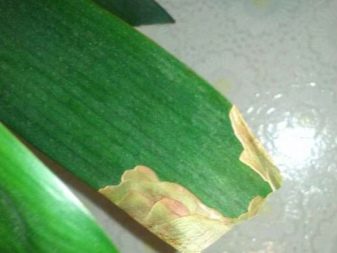
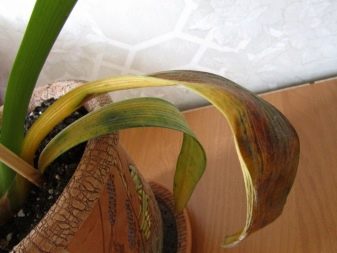
It is important to suspend irrigation for a long time, after which it is imperative to wait for the top layer of the earth to dry out, and also to remove the damaged parts of the plant. Brown spots on the leaf plates are the result of sunburn. To solve the problem, it is enough to move the pot or protect it with a screen from direct sunlight. The pallor of clivia is the result of insufficient supply of nutrients to the soil.
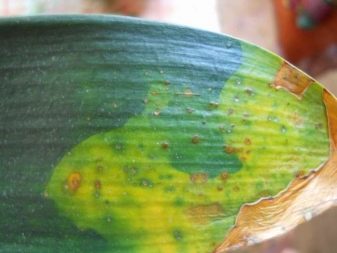
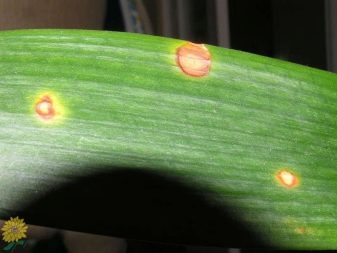
See the next video for more on cleavage care.























The comment was sent successfully.